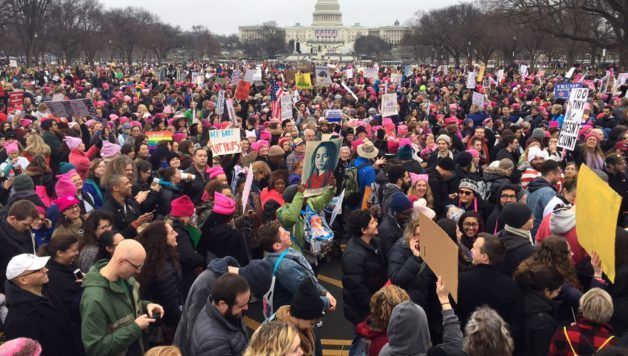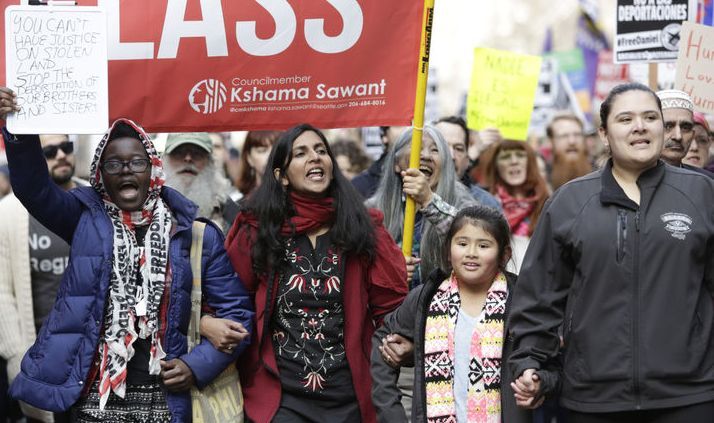Sarah Sachs-Eldridge is a member of the Socialist Party (CWI in England & Wales).
Million

s of women led protests across the world against the bigoted new US president – the biggest ever inauguration demos. They form part of a much wider struggle to defend and extend women’s rights.
On 21 January 2017, the day after Donald Trump’s inauguration, a surge of resistance exploded onto the streets of 673 cities and towns across the world. Around five million women, children and men participated in the Women’s Marches. Three to four million demonstrated in the US where upwards of 550 marches formed the biggest ever presidential inauguration protests. Such numbers on the streets indicate the underlying support of the mass of the population behind them.
There is historical precedent for women taking the first steps in powerful movements. The outbreak of the French revolution in 1789 saw women march on Versailles. On 8 March 1917 women textile workers went on strike in several factories in Petrograd which led to mass demonstrations. These opened the floodgates to the Russian revolution which not only removed the brutal warmongering tsar but put society in the hands of the working class to run it democratically in the interests of all. If today’s marches are to be seen in a similar way by future generations will be determined by whether a correct programme to reach the wider masses can be developed, what organisations grow from it, and its leadership.
Energetic militancy has not been lacking. Within 48 hours of Trump’s election victory in November 2016, 40,000 had marched, many inspired by the call from Socialist Alternative, the Socialist Party’s co-thinkers in the US. This and their call for inauguration protests and student walkouts helped to set the tone of organised active rejection of the bigoted racist president who was busy stuffing his administration with fellow billionaire business people. This was in contradistinction to the hopes of the Democratic Party leadership that, having failed to defeat Trump, they could lead that opposition.
Days after the marches, Trump’s so-called Muslim ban was answered within hours by airport occupations and protests and by the one-hour strike of Uber drivers, and by Yemeni shop owners. Quinniapac polls suggest that these protests have contributed to a twelve point net swing against the general idea of the travel ban in the month to 7 February, the period during which the protests took place. A mass movement has the potential to not only effectively push back against racist and other attacks, but also to promote a different type of society based on solidarity and democratic planning to meet the needs of all.
This is an answer to the pessimism of many on the left who lack confidence in working class people to act and be convinced to act. It also answers the Blairites who argue they have no choice but to take their cue from the lies of the right wing, such as the UK Independence Party (UKIP), rather than attempting to channel people’s anger at their deteriorating conditions into a united struggle for socialist change in the interests of the overwhelming majority of people.
The women’s marches’ size, composition and energy indicate that, following Trump’s election and the inability of the Democrats to defeat him, millions of people not only reject him but believe that they must act themselves because capitalist establishment leaders and their parties of the rich cannot be trusted to rule. The slogans and mood signify a yearning and readiness to fight for an inclusive society that can provide a dignified life for all people regardless of gender, sexuality, race, etc.
The ongoing fight for women’s rights
Although a common slogan on the march was, ‘the future is female’, the protests when Betsy DeVos was confirmed as secretary of education showed that there are no illusions that a female billionaire will defend women any better. The understanding that it is whose interests you represent which is important – not who you are – was made more conscious during the Hillary Clinton verses Bernie Sanders contest.
Indisputably, Trump’s brazen misogyny was a major impetus for the marches. The ubiquity of pink ‘pussy hats’, inspired by Trump’s 2005 comments in which he bragged about grabbing women by their genitals, is testament to this. During the election campaign Trump threatened to defund Planned Parenthood which is the biggest abortion provider in the US, among other services it delivers. Among the placards, the idea of defending women’s rights indicates an understanding that previous gains could be unwound by an emboldened billionaire right-wing Republican administration.
Internationally, women’s marches and protests have been a feature of the recent years of capitalist crisis. The number of battles for and to defend women’s rights reveals, on the one side, the radicalisation of big sections of working class people and a rejection of establishment influence and rule. On the other side, the desperate attempts by unpopular or unstable regimes to use social issues to try to maintain power. While majority support for abortion rights is stable at about 2:1 in the US, Trump, who lacks any organised force on which to base himself, relied on right-wing anti-abortion groups to campaign for him. The quid pro quo appears to be the selection of anti-choice Mike Pence as vice-president and other appointments. But half of Trump voters support funding Planned Parenthood.
In Ireland the energetic and largely youthful campaign for the introduction of abortion rights is understood as a fight against establishment austerity politicians who still kowtow to a Catholic church that has lost its influence over the masses. In the US rights that have been won by previous generations and that were seen as secure are under threat in this era of capitalist crisis. This understanding, at different levels throughout the movements, contributes to the sense that the fight for women’s rights is ‘our task’.
It is also the case that in every country women have borne the brunt of the years since 2007/08 when governments across the world have made the working class and poor pay the price for the world economic crash. Cutting and privatising public services means women suffer job losses, the reduction or denial of services they rely on including cruel cuts to refuges for women fleeing domestic violence, and often have to take up the slack in the family for the lack of access to care services. Housing and job insecurity can mean that women also feel less confident to stand up against sexist bosses or abusive partners.
In Britain 2016, analysis showed that women have lost an average of between £1,000 and £1,700 a year through austerity, with low-paid women, especially black and Asian women and single mothers suffering the most. This is evidence that under capitalism, even where oppressed groups make gains, they are never guaranteed to be permanent. Crisis-ridden 21st century capitalism, far from taking steps forward for all women, is driving in the opposite direction.
Pervading sense of solidarity
A large proportion of the 21 January marchers were on their first protest. The predominance of home-made placards showed that the numbers attending were not a sign of the authority of any particular organisation but of the widespread feeling of the need to act, to organise. The slogans also showed that this is a very inclusive and expansive movement.
Over the last few years a number of more ‘single issue’ movements have erupted: for trans rights, against police racism, against the cut-backs to services and benefits for people with disabilities, etc. Particularly where these movements have been visibly and vocally led by those affected they have inspired solidarity. Of course, there are also major attempts by the establishment to sow divisive ideas – look at the amount of airtime, disproportionate to its size, given by the BBC to UKIP for example. But that has also served to undermine the legitimacy of the establishment media.
A new sense of solidarity pervades, especially invoked by the movement around Bernie Sanders, above all among young people. It can be seen in the results of a survey conducted on behalf of the Victims of Communism Memorial Foundation. This found that 64% of millennials agreed with the words of Karl Marx: “From each according to his abilities, to each according to his need”, not the result they expected.
Attitudes to LGBT+ people have been transformed in recent years, especially among young people. A 2015 YouGov poll found that 23% of British people define themselves as something other than 100% heterosexual and the figure rises to 49% among 18-24 year olds. In the 2015 Irish referendum on equal marriage, the votes of young people and working class people ensured the victory. In the US, 40% of white people express support for Black Lives Matter, but this rises to around 60% for those under 30. The campaign to oppose the North Dakota pipeline inspired solidarity with Indigenous Americans including by war veterans. The new generation has already rejected many of the old divisive ideas and is seeking a new form of inclusive society.
But this general mood of solidarity and opposition to attacks needs to be articulated through a programme which can then aid the movement in reaching out beyond those involved so far, including to working class Trump supporters. The vast majority did not vote for Trump because they are sexist and they liked that he is a misogynist. Of the 26% of eligible voters who backed him, many did so because they are so angry at their conditions and correctly saw Clinton as Wall Street’s candidate who sought to maintain the status quo.
Involving these people means being firm in fighting oppression, organising against the attacks on refugees and migrants, for women’s rights, for LGBT+ rights, against police racism, etc. But it also requires linking that movement to the bold demands that gained widespread support over the last few years, most prominently in the campaign of Bernie Sanders to be the Democratic presidential nominee: for a $15 an hour minimum wage; fighting for free healthcare and education. In fact the Sanders campaign was emboldened to expand its program by the movement – which his stand inspired – so that it both opposed oppression and demanded better conditions for all, linking that to the idea of a political revolution and the general idea of a socialist alternative. This program needs to be filled out to show that the movement is serious about taking the wealth off the 1% with demands for the democratic nationalisation of the banks and big corporations that dominate the rigged economy.
Establishment tries to ride protest wave
However, various attempts are being made to rebuild the authority of establishment politicians through this new movement. Speakers at the Women’s March in Britain included Blairites like Stella Creasy, who voted to cut benefits, and Yvette Cooper, who called for the Remain campaign in the EU referendum to go further than David Cameron’s attacks on EU migrants. They have been part of the campaign to remove Jeremy Corbyn and keep Labour as a party that can be relied on to defend capitalist interests, including attempts to use so-called feminism to attack him. But their one-dimensional anti-Trump message, bereft of ideas about how to fight Trumpism – whose rise they facilitated – will not gain widespread influence as this movement searches for a way to transform society. Likewise, the attempts in the US by Hillary Clinton and the Democrats to claim the mantle of opposition leaders will not be widely accepted.
A coalition of Blairites, Lib Dems and others behind the journalist Owen Jones is seeking to link the anti-Trump movement to opposition to Brexit. This would mean cutting it off from half the population – including many conscious anti-racists and anti-sexists and those who could be won to that position. A campaign to expose these Remainers’ ultimately pro-capitalist, pro-status quo, pro-austerity ambitions must also propose a clear internationalist socialist Brexit in the interests of working class people.
Comparisons are correctly being made with the 2003 mass anti-war movement. But there is a crucial difference: that was before the 2007/08 world economic crisis. Since then hatred and scepticism of establishment politicians have skyrocketed. Like then, celebrities and politicians will be promoted but, if the movement is built on the basis of uniting the mass of working class and young people in struggle, its own leaders will emerge – of all genders.
The capitalist class is attempting to intervene in other ways and rebuild reputations damaged by tales of tax evasion, etc. On 30 January the BBC website reported: “Google, Apple, Twitter and numerous other multinational companies have taken action in response to an immigration ban imposed by President Trump”. Starbucks CEO Howard Schultz pledged that his chain would hire 10,000 refugees. Yet in 2014, Schultz (then on $9,637/hour) responded to the $15/hour uprising by stoking fears about job losses at small businesses which, he claimed, “would not be able to afford it”.
The two superpowers
In 2003, the New York Times, the USA’s leading capitalist newspaper, wrote that “there may still be two superpowers on the planet: the United States and world public opinion”. This response indicates that ‘public opinion’ – in other words, the movement – is once more a factor, even before it has its own political voice. In the aftermath of the marches and the excitement they generated there is a huge amount of discussion and debate on social and ‘alternative’ media sites about what to do next.
It is significant and very welcome that discussion on strike action is prominent. Last October women in Poland won a crucial victory as proposed legislation to impose a near-total ban on already restricted access to abortion was overwhelmingly defeated. An estimated 140,000 women in over 60 cities took part in a national ‘women’s strike’ opposing the ban. As a direct result, the Polish parliament was forced back, voting 352-58 against it.
Activists in Ireland, which has seen a small but significant strike wave, in the movement to repeal the eighth amendment which bans abortion, have called for similar action on International Women’s Day. This is part of a trend in the era of capitalist crisis, of those in struggle reaching for the methods of the workers’ movement to fight their battles, as was the case with the dispute by Britain’s junior doctors who are majority female (54% of training grade doctors).
While strike action remains at a low level in the UK this is especially the case in the US. Nonetheless, strikes in sectors dominated by women workers have been to the fore and have taken a more ferocious character. For decades the feminisation of health and education has gone hand in hand with privatisation and the driving down of workers’ conditions. The low level of action is not an expression of the mood or readiness to fight, as proven by the way the $15 campaign spread like wildfire. It is the trade union leaders who have completely abdicated responsibility. A bonfire of workers’ rights took place under Barack Obama’s administration, such as the Right to Work legislation which Trump plans to escalate.
It is therefore understandable that many young people have a hazy understanding of what a strike is and its potential, especially general strikes which pose the question of power. A strike is not only a protest – putting ‘sand in the gearbox’ as some of those proposing it have said – or a folding of arms but a show of power. It is a promissory note of how the working class when organised is potentially the most powerful force in society and capable of democratically running society for the overwhelming majority.
What is being discussed at this stage would have more the character of a hartal, with aspects of a mass ‘sickie’, as wide sections of the population walk out. This would include small business people, students, those who stay at home to care for children and family members, etc. Socialists welcome this opportunity to help popularise the need for workers’ strikes and to patiently explain the need to build them in a serious way to fully harness the collective power of the working class. This includes recognising the weakness of the trade unions at this stage and how they can be transformed. It also means timing – there is a risk that a small combative layer could be attacked and that, therefore, the watching masses could be intimidated rather than inspired.
Women fight the system
However, the understanding of class society will be hammered out through experience. An indication of this was borne out in an Ipsos Mori poll last March which found that millennials in the US see themselves as more working class than any other generation since records began three decades ago. Socialist Alternative in the US is both explaining this and putting forward ways to build for effective action that can unite the working class.
It is significant that the concept of a ‘feminism of the 99%’ has been thrown up. This is a very good slogan. The task is to give it content and a strategy for action to win women’s rights and a society in the interests of the vast majority. It shows how the experience of the years of crisis are impacting on society, starting to bring together the lessons from Occupy, Black Lives Matter, solidarity with trans people, etc.
A feminism of the 99% points to the connection between fighting women’s oppression and fighting the capitalist system which is run in the interests of the 1%. The roots of women’s oppression date back thousands of years to the rise of class society, private property, and the family as an institution of economic and social control. But it is important to recognise that sexism, the product of class society, is part of a wider ideological apparatus which helps to maintain the capitalist system in place. In this respect, understanding and challenging sexism is not peripheral. It is central to the struggle for an end to inequality and oppression.
Some groups have called for the next action to be around the slogan of opposing male violence. Given that worldwide an estimated 30% of women who have had a partner have suffered ‘intimate violence’, there is no question but that the movement must challenge it. Nonetheless, the vigorous fight for women’s rights cannot be effective if all men are deemed responsible for violence against women. So this slogan must be part of a programme that can make it clear to ‘the 99%’ that their interests are best met by joining this movement. Not only is this correct, it is vital if it is to succeed in ending women’s oppression. Defending and fighting for women’s rights is a task of the working class fighting to change society.
Ending violence, discrimination and oppression against women requires a fundamental transformation in the way that society is structured and organised. Through democratic workers’ control and management of industry, moving away from a system based on inequality and exploitation to one founded on equality and co-operation, it would be possible to not just end the economic problems which women face, but to prepare the ground for eliminating cultural oppression too. Movements towards collective action by workers, including the vital building of a new mass workers’ party out of the experience of both the Bernie Sanders and anti-Trump movements, will be critical steps in the struggle for socialism.
 s of women led protests across the world against the bigoted new US president – the biggest ever inauguration demos. They form part of a much wider struggle to defend and extend women’s rights.
On 21 January 2017, the day after Donald Trump’s inauguration, a surge of resistance exploded onto the streets of 673 cities and towns across the world. Around five million women, children and men participated in the Women’s Marches. Three to four million demonstrated in the US where upwards of 550 marches formed the biggest ever presidential inauguration protests. Such numbers on the streets indicate the underlying support of the mass of the population behind them.
There is historical precedent for women taking the first steps in powerful movements. The outbreak of the French revolution in 1789 saw women march on Versailles. On 8 March 1917 women textile workers went on strike in several factories in Petrograd which led to mass demonstrations. These opened the floodgates to the Russian revolution which not only removed the brutal warmongering tsar but put society in the hands of the working class to run it democratically in the interests of all. If today’s marches are to be seen in a similar way by future generations will be determined by whether a correct programme to reach the wider masses can be developed, what organisations grow from it, and its leadership.
Energetic militancy has not been lacking. Within 48 hours of Trump’s election victory in November 2016, 40,000 had marched, many inspired by the call from Socialist Alternative, the Socialist Party’s co-thinkers in the US. This and their call for inauguration protests and student walkouts helped to set the tone of organised active rejection of the bigoted racist president who was busy stuffing his administration with fellow billionaire business people. This was in contradistinction to the hopes of the Democratic Party leadership that, having failed to defeat Trump, they could lead that opposition.
Days after the marches, Trump’s so-called Muslim ban was answered within hours by airport occupations and protests and by the one-hour strike of Uber drivers, and by Yemeni shop owners. Quinniapac polls suggest that these protests have contributed to a twelve point net swing against the general idea of the travel ban in the month to 7 February, the period during which the protests took place. A mass movement has the potential to not only effectively push back against racist and other attacks, but also to promote a different type of society based on solidarity and democratic planning to meet the needs of all.
This is an answer to the pessimism of many on the left who lack confidence in working class people to act and be convinced to act. It also answers the Blairites who argue they have no choice but to take their cue from the lies of the right wing, such as the UK Independence Party (UKIP), rather than attempting to channel people’s anger at their deteriorating conditions into a united struggle for socialist change in the interests of the overwhelming majority of people.
The women’s marches’ size, composition and energy indicate that, following Trump’s election and the inability of the Democrats to defeat him, millions of people not only reject him but believe that they must act themselves because capitalist establishment leaders and their parties of the rich cannot be trusted to rule. The slogans and mood signify a yearning and readiness to fight for an inclusive society that can provide a dignified life for all people regardless of gender, sexuality, race, etc.
s of women led protests across the world against the bigoted new US president – the biggest ever inauguration demos. They form part of a much wider struggle to defend and extend women’s rights.
On 21 January 2017, the day after Donald Trump’s inauguration, a surge of resistance exploded onto the streets of 673 cities and towns across the world. Around five million women, children and men participated in the Women’s Marches. Three to four million demonstrated in the US where upwards of 550 marches formed the biggest ever presidential inauguration protests. Such numbers on the streets indicate the underlying support of the mass of the population behind them.
There is historical precedent for women taking the first steps in powerful movements. The outbreak of the French revolution in 1789 saw women march on Versailles. On 8 March 1917 women textile workers went on strike in several factories in Petrograd which led to mass demonstrations. These opened the floodgates to the Russian revolution which not only removed the brutal warmongering tsar but put society in the hands of the working class to run it democratically in the interests of all. If today’s marches are to be seen in a similar way by future generations will be determined by whether a correct programme to reach the wider masses can be developed, what organisations grow from it, and its leadership.
Energetic militancy has not been lacking. Within 48 hours of Trump’s election victory in November 2016, 40,000 had marched, many inspired by the call from Socialist Alternative, the Socialist Party’s co-thinkers in the US. This and their call for inauguration protests and student walkouts helped to set the tone of organised active rejection of the bigoted racist president who was busy stuffing his administration with fellow billionaire business people. This was in contradistinction to the hopes of the Democratic Party leadership that, having failed to defeat Trump, they could lead that opposition.
Days after the marches, Trump’s so-called Muslim ban was answered within hours by airport occupations and protests and by the one-hour strike of Uber drivers, and by Yemeni shop owners. Quinniapac polls suggest that these protests have contributed to a twelve point net swing against the general idea of the travel ban in the month to 7 February, the period during which the protests took place. A mass movement has the potential to not only effectively push back against racist and other attacks, but also to promote a different type of society based on solidarity and democratic planning to meet the needs of all.
This is an answer to the pessimism of many on the left who lack confidence in working class people to act and be convinced to act. It also answers the Blairites who argue they have no choice but to take their cue from the lies of the right wing, such as the UK Independence Party (UKIP), rather than attempting to channel people’s anger at their deteriorating conditions into a united struggle for socialist change in the interests of the overwhelming majority of people.
The women’s marches’ size, composition and energy indicate that, following Trump’s election and the inability of the Democrats to defeat him, millions of people not only reject him but believe that they must act themselves because capitalist establishment leaders and their parties of the rich cannot be trusted to rule. The slogans and mood signify a yearning and readiness to fight for an inclusive society that can provide a dignified life for all people regardless of gender, sexuality, race, etc.




